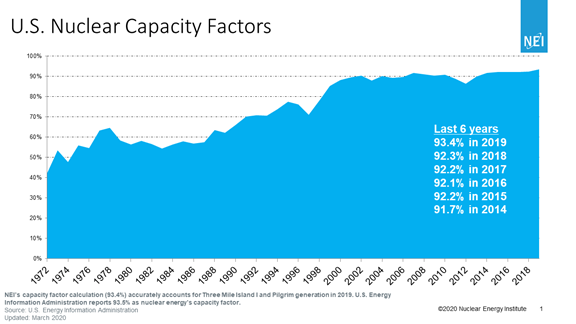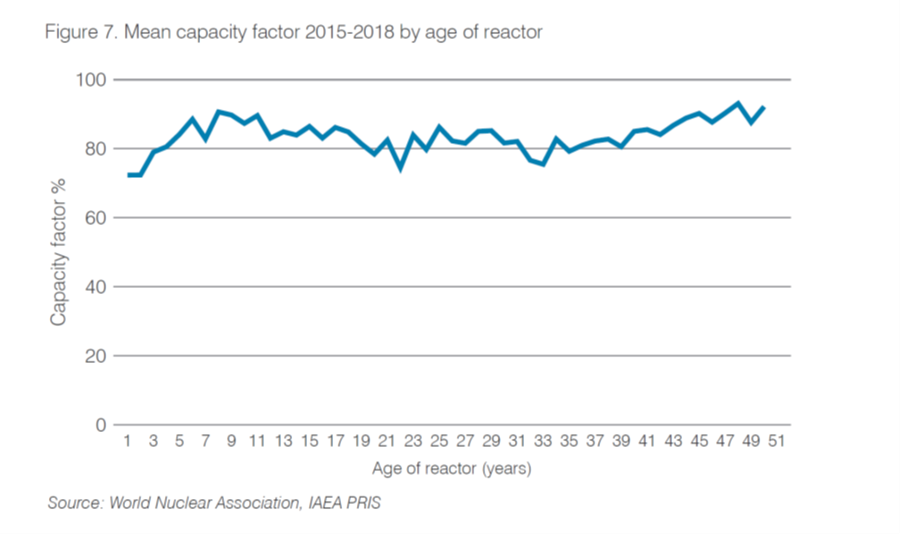Delivering reliable electricity – nuclear plants just keep on running
On October 22, 2020 Darlington Unit 1 achieved a milestone never achieved before by a nuclear power plant running for 1,000 days continuously without an outage, either unplanned or planned1. And it is still running. This unit, operated by Ontario Power Generation (OPG) secured the world record for continuous operations last month, when it hit 963 days to take over from the Kaiga 2 unit in India, the previous record holder at 962 days achieved in 2018. Kaiga took the record from Heysham 2 in the UK which reached 940 days in 2016 breaking the record set by the Canadian Pickering Unit 7 reactor 22 years earlier2.
Why does this matter?

The world runs on energy. We need it to keep warm (or cool, depending upon the climate), cook our food, light our homes, communicate with one another and travel from place to place; and to enable pretty much everything that drives our economies. We need this energy to be affordable and most of all, we need it be reliable. For most people in the developed world, we fully expect that when we flip the switch, the lights will come on. Not sometimes, but each and every time. We also want this energy to not harm the environment (although unfortunately we will concede on the environment rather than do without).
And there is no more reliable low carbon source of energy than from nuclear plants. Once in operation, they just run and run and run, like the energizer bunny. These plants run in bad weather and good, during the day and during the night, providing 24 / 7 electricity to their customers.
System reliability is not something we often think about until we experience an issue. It came as a shock to many this year when California suffered ongoing blackouts and energy shortages. There are many contributing factors to poor reliability as electricity grids are complex systems that require a never-ending balance between supply and demand, meaning a need for reliable generation and a robust transmission and distribution system. In this case, the California Independent System Operator described the conditions that caused demand to exceed available supply: scorching temperatures and diminished output from renewable sources and fossil-fuelled power plants when electricity was needed most.
The president of the system operator blamed the California Public Utilities Commission for not ordering companies to make available sufficient supply. A critical issue is the changing mix of generation with solar growing quickly without sufficient back up when the sun goes down and the air conditioning load remains high. This demonstrates that solar power alone cannot meet the future energy needs of large energy intense systems like that of California, and that reliability must always be considered as we make structural changes to these systems.
On the other hand, the US nuclear fleet continues to hum along providing 20% of the country’s electricity supply.

Once again in 2019, the US nuclear fleet operated at a very high capacity factor (the percentage of time the plant is producing compared to if it ran 100% of the time) achieving 93.4%. The US fleet continues this stellar performance, even as it is aging. For the past 20 years the fleet has produced in the range of 90% capacity factor or more, demonstrating how robust a technology nuclear power really is.
This is not just true of the US. It is true for the entire global nuclear fleet. As shown in the WNA Nuclear Performance report 2020, more than a third of the world’s plants operate at 90% capacity factor or above and a full two thirds operate at capacity factors greater than 80%.
Nuclear technology is so robust that this excellent performance is not restricted to one specific type of plant. Light water reactors, gas cooled reactors, heavy water reactors – they all operate great. The distinguishing factor is more related to the expertise and excellence of the individual operator and to specific local market conditions, not to any specific technology. International cooperation through organizations like INPO (Institute of Nuclear Power Operators) and WANO (World Association of Nuclear Operators) ensure best practices are shared and that all have access to the tools they need to achieve a high level of performance. This is an industry that collaborates to ensure continuous improvement across the global fleet.
What really demonstrates the strength of nuclear technology is the continued strong performance, even as the plants age. Heysham achieved it record run at 28 years of age and Darlington Unit 1 is 30 years old with only a year or so left before going down for refurbishment and a life extension outage. Many would expect that the life cycle of a nuclear plant would look like an inverted bathtub, with less than average performance when it is new as the kinks are worked out and then declining performance with age as it nears its end of life. But this is not the case. Nuclear plants run well when they are new, when they are middle aged and actually tend to run their very best as they get old.

Need reliable electricity supply even when the sun is not shining, and the wind is not blowing? When it comes to reliable low carbon electricity, nuclear plants set the bar very high. They just run and run and run some more…….
1 Every station in Canada had at least one unit set a station performance record this year.
2 It should be noted that the AGR units in the UK and the PHWR units in Canada and India use on-power fuelling, so they are not limited by the need for refuelling outages.





1 Comment
Boganboy · October 28, 2020 at 2:30 am
Obviously if we really wish to reduce the CO2 output of Oz, we should build nukes not solar or windmills. Fat chance of that.
Comments are closed.